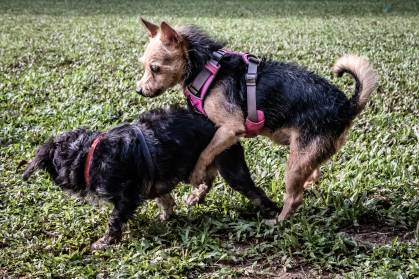Connect with a verified veterinarian in minutes. Licensed vets are available 24/7 to answer your questions. No need to worry about your furry family member.
Some female dogs are very active when it comes to thrusting (humping). But what causes this behavior? Isn’t it only male dogs that thrust?
Is your female dog thrusting? Are you worried about her behavior? If so, you’ve come to the right place. We understand this can be a concerning issue, especially when you’re not sure how to handle it.
We’ve put together some information about what causes a female dog to thrust and what you can do to help your dog. Let’s get started!
What Causes a Female Dog to Thrust?
Many pet parents believe that only male dogs hump or thrust. However, that’s not the case. It’s not uncommon for female dogs to thrust, too. But why?
There are several reasons a female dog may thrust, including:
1. Puppies Mounting
If you have a female puppy who is exhibiting mounting behavior, this is perfectly normal. Puppies from about the age of 6 weeks may begin mounting their litter mates.
Puppies are exploring their bodies and their environment. As they experiment, puppies typically chew up everything in sight due to teething. And as they explore their bodies, puppies may show thrusting behavior. Both female and male puppies engage in this activity. This is all in play at this age!
2. Excitement or Anxiety
The feelings of excitement and anxiety may lead a female dog to thrust. This can happen with any female dog, but especially in those that have not been properly socialized. Thrusting or humping is a way for the dogs to release the energy that goes along with excitement or anxiety.
3. Stress
Female dogs may also thrust if they’re stressed. Some stressed dogs may bark a lot, hide, lick themselves, and more. But some female dogs turn to thrusting when they’re stressed.
4. Thrusting May Be a Sign of Dominance
Thrusting in female dogs can also sometimes be a sign of dominance. This is not common in female dogs, but it can happen.
Remember that dogs are social animals who live in packs. There’s usually one male pack leader and a female pack leader. The female leader may show dominance by thrusting with other dogs in the pack.
5. Medical Conditions
There are certain medical issues that may also cause a female dog to thrust, including a UTI (urinary tract infection), allergies, bladder infection, and more. If a female dog has a medical condition causing irritation or pain in her private areas, she may try to relieve these symptoms by thrusting on toys, pillows, or even furniture.
How to Help Your Dog
If you have a female puppy that’s young and is thrusting other dogs, this behavior will probably pass on its own. Just try to distract her with toys, affection, and exercise. These may be enough to keep the behavior from becoming a habit.
For dogs that are showing other signs of illness (lethargy, not eating, and more), it’s best to call the vet. They need to examine your dog for an underlying medical condition. In most cases, once the condition is treated, the female dog stops thrusting.
And if you have a female dog that seems compulsive about thrusting or is causing other dogs or humans stress through this behavior, it’s best to consult with the vet. They may refer you to a professional dog behaviorist who can work with you and your dog to end this thrusting behavior.
Connect with a verified veterinarian in minutes. Licensed vets are available 24/7 to answer your questions. No need to worry about your furry family member.

Julie
Julie is a graduate of the University of North Carolina, Wilmington, where she studied Animal science. Though contrary to the opinion of her parents she was meant to study pharmacy, but she was in love with animals especially cats. Julie currently works in an animal research institute (NGO) in California and loves spending quality time with her little cat. She has the passion for making research about animals, how they survive, their way of life among others and publishes it. Julie is also happily married with two kids.
Review symptoms, medications & behavior to keep your pets healthy with a Vet Online in just minutes.
Ask a Vet Live Now

